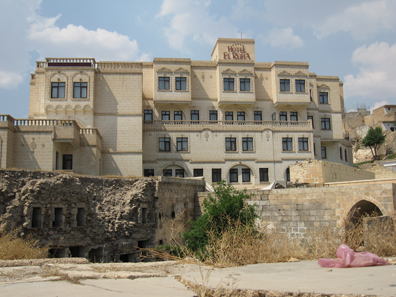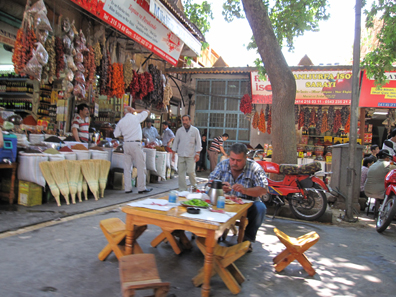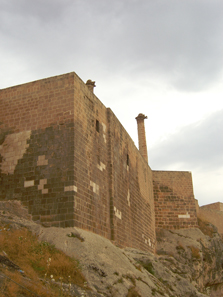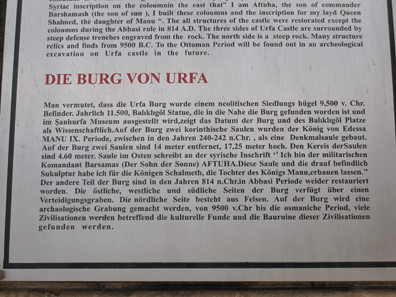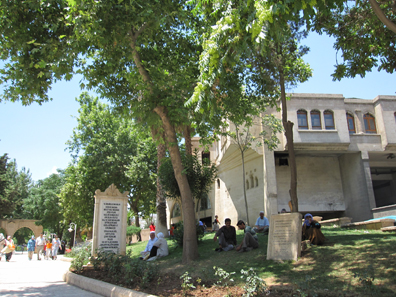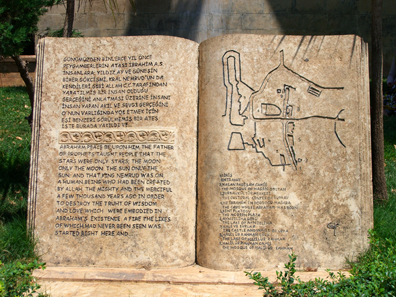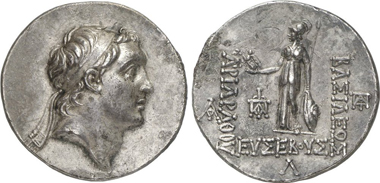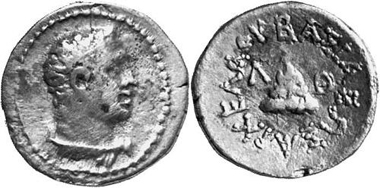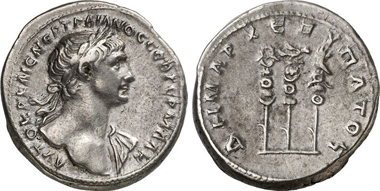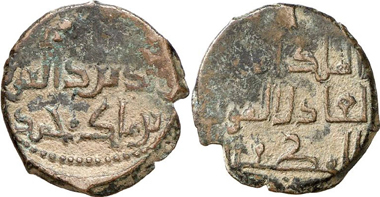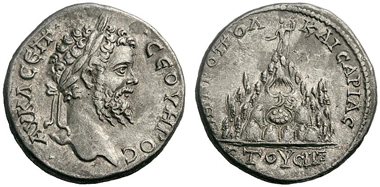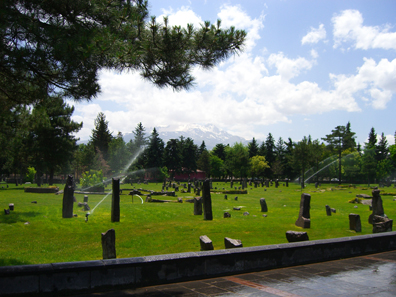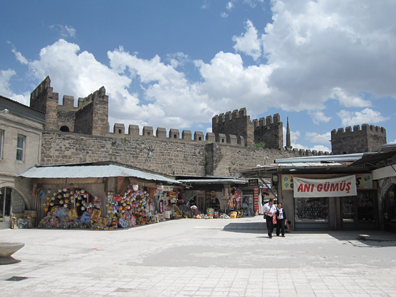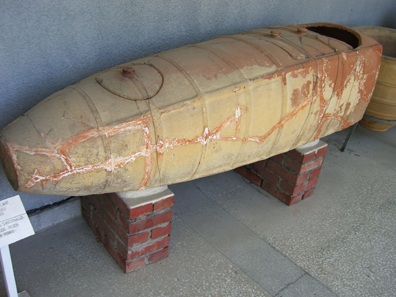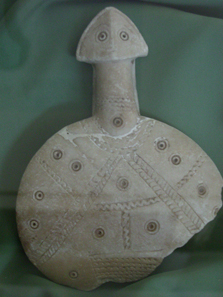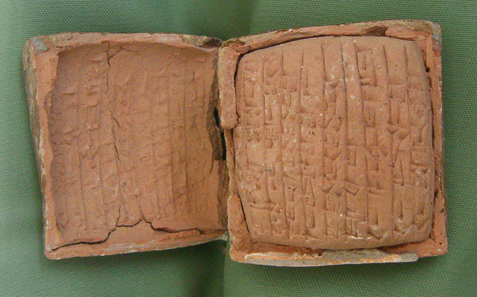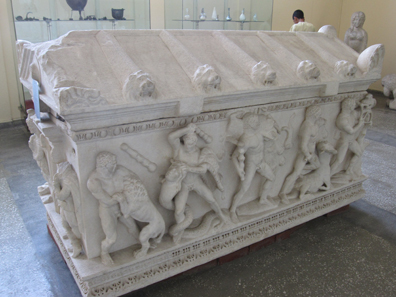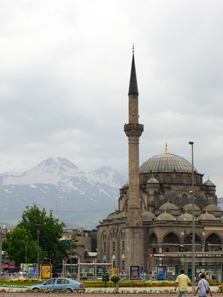by Ursula Kampmann
March 8, 2012 – Caesarea Cappadocia – only few cities in the Roman provinces possessed an equally comprehensive coinage yet barely anything Roman is still extant in the city.
June 23, 2009
After our trip to Nemrut Dag we were exhausted. But that was no problem at all, since we changed our bedraggled bunker à l’Americain for a haven of recreation in the El Ruha Hotel. We could even move into our room in the morning. So we just left our luggage and went for the fish ponds to sit down in the shade, have something to eat and feed the carps.
El Ruha Hotel, a haven of recreation. Photograph: KW.
There isn’t much to report about this day. We were lazy. Oh, but there is something. We discovered a drinks menu containing cocktails in our hotel. That was a surprise because, strictly speaking, there is no such thing as alcohol (not in the local tea gardens and restaurants either). But it was all over the menu, Pina Colada (even the spelling was almost correct). Of course, we had to have a try. So we ordered two Pina Coladas. What was served? No idea. It was red, incredibly sweet, a taste ranging somewhere between chewing gum and gummy bears, simply undrinkable. We brought our glasses back to the bar, and the adorable waitress in her traditional Turkish garb explained in the best Turkish: Ananas yok, Rum yok, Kokos yok. Oh well, ‘yok’ means ‘we do not have’…
A view inside the bazaar. Photograph: KW.
June 24, 2009
We were busy the entire morning with strolling through the bazaar. It was amazing! There was actually an alley with copper smiths with the craftsmen working. The offer of the cheapest clothes is huge, and there are countless cook-shops with a low table and little stools. The customers sit down and eat what they are being served from the grill. This country surely is not for vegetarians (or people like me who eat meat in moderation). I am sick of kebab!!!
A view inside Ulu Cami, a church built by Justinian. Photograph: KW.
From the bazaar we headed for the old mosque. This was where Justinian erected a church in the middle of the 6th century for St Stephen. The only extant remains are the ancient capitals on display in the garden. The octagonal minaret used to be the church’s bell tower.
View at the citadel. Photograph: UK.
In the evening, we went to the citadel. We found the right stairway and, to our surprise, noticed that there were even explanatory boards in several languages.
Try to read that for once. Photograph: KW.
We were just remarking that they even bothered to provide information in German when we heard a voice from behind saying: “But just look, what a German!” It was unbelievable. The text was entirely lacking any content! We laughed and were right in the middle of a conversation with fellow Germans. Their names were Thomas and Christian, they came from Tuttlingen, read Technical Biology and Architecture, respectively, and were on a journey across Turkey. We invited them to dine with us at the fish ponds. It became a merry evening. They planned on going to see the cock fight and would gladly have taken us with them. But we refused. I don’t suppose that anybody would have let me anything near a cock fight arena around here.
June 25, 2009
This was our last day in Urfa. We had a busy schedule ahead. After all, we virtually hadn’t seen anything of the city so far. I wanted to see the Archaeological Museum but that didn’t work out. The museum hid from us. Eventually we found it only to discover that it wasn’t the one we were looking for but yet another of these countless Atatürk museums.
Practically every city has one of these. On his journey, The Father of the Turks must have left any number of shirts, pairs of suspenders, canes and rifles. Every place he just stopped to have a cup of tea is a memorial site today. In Urfa this memorial is situated in a very nice, recently renovated building where the entrance is free. One can see some showcases with weapons, a shirt and a weskit of Atatürk’s as well as a group of grave Turks in wax, stiff as a poker, taking charge of their country’s fate. For this curious memorial site we had walked across the city in the heat! We were annoyed, with each other, with the museum (by the way, the guard had been very nice and couldn’t be blamed for our frustration at all), the heat, the city, with anything and everything.
Relaxing at the fish ponds. Photograph: KW.
We took a break at the general post office, the building with the best air-conditioner in town. After that we were ready for the fish pond. It is safe to assume that in Urfa we have seen nothing as extensive as these little lakes. On the other hand, there we had open air theater live: Turkish families on holiday.
This day, a big family occupied the place next to us. The grandmother was severely disabled, sat in the wheelchair and was affectionately cared for by various granddaughters. In contrast to the family that was sitting on a big table in the second row, the granny had been positioned close to the fish pond. There was always one of the young ladies there to entertain her.
I had already noticed that young Turkish ladies readily smile back when being smiled at. Amongst women that is no offence and it nearly always prompts a reaction. Hence, I smiled at the grandmother’s caretaker. She smiled back. Granny, sitting with her back to me, undoubtedly – although naturally I didn’t understood a word – asked for the reason of her granddaughter’s smile. It was explained to her. A short command and granny, together with her wheelchair, was turned around to get a good look at the tourist. The first contact was established, using a few English phrases: “Where do you come from? What’s your name? My name is …” Once she realized that we came from Germany they were all excited. A girl was called which read Veterinary Medicine in Gießen and spoke German very well. We, meaning she and I, talked. Very soon a crowd of female beings had gathered around us and watched. They stood behind and next to Kurt but it was as if he wasn’t there at all. They didn’t deign to look at him, while having a good time chatting with me. It is true: women chitchat without addressing the man, and men talk without paying the women any attention. One stands next to each other and yet the different spheres are poles apart, seemingly unable to come together.
Stone board with a layout of the site with the Grotto of the Nativity of Abraham. Photograph: UK.
In the evening we had a walk through the site to find the Grotto of the Nativity of Abraham. We didn’t find it, though – we’ll get over it. It is simply unbelievable how the heat sucks any energy out of you.
View from the bus window on a gorgeous landscape. Photograph: KW.
June 26, 2009
On Friday, we left Urfa with a heavy heart. After roughly three hours we reached Gaziantep and noticed that a bus heading for Kaysari, ancient Caesarea Cappadocia, left there. So we bought tickets and departed half an hour later. It was said to be a 6.5 hour drive. It went through an incredibly beautiful mountainous scenery. Finally, we reached mountainous Cappadocia. We arrived in Kaysari late in the evening. We were dog-tired, hungry and had to find ourselves a hotel. But we were lucky. The staff at the reception spoke English. The rooms were just what we needed. And for dinner they served Raki again. It is funny, ordinarily I am no person who keeps needing a beer for dinner but the mere fact that someone tries to prevent me from drinking one makes me want to drink alcohol. The old spirit of contradiction sends its love.
June 27, 2009
Kayseri, Roman Caesarea is an age-old cultivated land. A settlement is said to have existed here as early as 3000 B. C. Its location near the Silk Road, an ancient trade route through Asia Minor to China, made sure that it continued to be an important commercial city under its various rulers.
Ariarathes IV. Tetradrachmn, 185/4. Gorny & Mosch 199 (2011), 526.
This is where the kings of Cappadocia had their residence from Ariarathes I (332-322) onwards. The city was called Mazaka back then. One of many successors of Ariarathes of the same name had it renamed into Caesarea. The motivation behind was to propitiate the Romans, Tiberius, to be specific, since the last king of Cappadocia entirely depended on the emperor’s good will.
Archelaos. Hemidrachm. Gorny & Mosch 142 (2005), 1613.
His name was Archelaos and he had risen to power thanks to the persuasiveness of his mother. She was a famous hetaira whose charms even the triumvir Marcus Antonius totally fell victim to. At least this the version told by the propaganda of Augustus. Allegedly, this had been the sole reason why Marcus Antonius made Archelaos King of Cappadocia. Anyway, Archelaos managed in time to change over to the opposite camp, to Augustus. He kept his crown and acted as a buffer to the Parthians for many years until Tiberius removed him from office to connect the kingdom to the Province of Syria.
Caesarea. Trajan. Tridrachm. Gorny & Mosch 204 (2012), 1859.
Contrary to the Empire of Commagene, Cappadocia remained under Roman control. The city became an important center of Roman power in central Asia Minor. The best witness for this are the countless coins issued in Caesarea. It is said that 400,000 citizens had lived there when Sassanid King Shapur I destroyed the city after his victory over Emperor Valerian I in A. D. 260. In the 4th century, a bishop established an ecclesiastical center a bit to the north-east of the old city. At this place the new city came into being which Justinian changed into a fortress.
Danishmendids. Fals, 536-570, Kayseri(?). Gorny & Mosch 172 (2008), 7066.
Under the Danishmendids and the Seljuqs Kayseri, as the city was called by then, remained to be an important center. The Ottomans, too, contributed to the layout of the city. As was already said, the Silk Road ran here and brought the city wealth. There are hardly any ancient remains to be viewed in Kayseri, but all the more mosques and caravansereis.
Caesarea. Septimius Severus. Didrachm. Numismatik Lanz 149 (2010), 436.
We spent the whole day exploring Kayseri. Admittedly, first and foremost I had come to see Mons Argaeus at last, the sacred mountain of the citizens of Caesarea who had it depicted on their coins instead of a cult image.
Muslim cemetery with Mons Argaeus in the background. Photograph: UK.
The city has a picturesque location at the foot of the mountain that is snow-covered even now. It is a volcano with two peaks, and actually bears resemblance to the depiction on the coins. Unfortunately, the mountain hides behind clouds this whole day. It was quite difficult to take a photo of him, even though we tried more than once.
The citadel with numerous built-in shops. Photograph: KW.
Today, Kayseri is an important center of carpet manufacturing and, most of all, the carpet trade. All Medieval mosques, madrassas, caravansereis are integrated into the bazaar. Even the citadel provides space for numerous small shops where the customer can buy all sorts of things, from children’s toys to clothes, jewellery and carpets.
Oh well, the carpets. And not to forget the dear touts. It is simply annoying. Once they realized that you speak a bit Turkish they address you, want to know where you are from, and a conversation begins in whose course they want tow their ‘good friend’ into one of the shops. It is merely impossible to resist in a polite manner. At some point, another one approached us, wanted to know in German where we were from. I was tired, thirsty, wasn’t in the mood and replied, without giving it any thought: “No, not again, I don’t want to buy any carpets.” That thwarted the man. He was literally speechless, and we got off without any major fight.
Clay sarcophagus typical for the Kayseri area. Photograph: UK.
First thing in the morning we ended up in the museum (it was an avoidance reaction: a man tried to drag us into a carpet shop and had followed us across half the city before we managed to make it clear to him that we had something different in mind. The museum was situated outside town. It is quite possible that it was the most decoyed building in the quarter – next to it there was an ultra-modern hospital. We were welcomed with excitement (in all probability, we were the first and only visitors of the day, if not the week or even the entire month) and sent into the two rooms.
Neolithic idol. Photograph: UK.
Big surprise: the objects were amazing. Marvelous Neolithic female idols were lying in a small showcase, plus superb Hittite ceramics, seals and tablets with cuneiform script, stelae and so on and so forth. There was so much to see even though the heat in the building almost made us suffocate.
Little tablets with cuneiform script. Photograph: UK.
Likewise annoying were the two boys sent to watch the tourists so that they couldn’t do any harm. Ever so inconspicuously they inspected what we had looked at, and on their little foreheads it was easy to read: “What on earth is so interesting about this crap?”
Sarcophagus depicting the 12 labors of Heracles. Photograph: KW.
The Roman section was a bit of a disappointment, even though the material was very good: a sarcophagus showing the 12 labors of Heracles, good gold jewellery including an enchanting earring with a detailed depiction of the head of Dionysus, small bronzes (everything heavily cleaned with any stains removed) – but not a single reference to Mons Argaeus. I was quite disappointed when considering the major role this mountain plays in numismatics! And not a single reference here!
Mosque, Mons Argaeus in the background. Photograph: UK.
We spent the afternoon strolling around all the Seljuq and Ottoman buildings. And such divine a temperature, barely 35 degrees Celsius anymore!
Tomorrow we will continue, probably to Ankara or wherever a bus will take us.
There was actually one heading for Ankara. Join us on our visit to the Museum of Anatolian Civilizations and the Mausoleum of Atatürk. I can promise you impressive pictures. Oh, by the way, did you know that Atatürk had possessed a small collection of coins, too?
You can read all other parts of this diary here.




